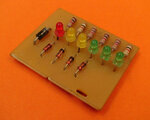Johanx2
Advanced Member level 4
Hi guys, I am in the way of put some leds to an active speaker that I am building. This speaker has 3 drivers, one is for bass, and two for voice and stereofonic sound. The amplifier board is one of those popular circuits you can find on ebay, which have two amplifiers class D, one bridged giving 100w to a subwoofer, and 50w+50w for the voice drivers. That board is bluetooth built in, and I have thought adding some leds to my enclosure, so these 25 leds will blink according to the music.
Somebody recommended me using the tip 31, which is a very simple circuit that is directly connected to power supply and audio source. But I just have some questions, althought I think this is what I am going to use.
Here is the circuit I found. As you can see, its very simple, but one guy told me that it need a resistor in the base of tip31, otherwise it will be burned, Is that really true? considering that it is receiving a very weak signal that came from the pre amplifier, this thing is not connected directly to the speaker, so is that necessary that resistor in the base?
![34q5hqp[1].jpg 34q5hqp[1].jpg](https://www.edaboard.com/data/attachments/64/64135-fff8074c0ee44f9224cdb1047deaf271.jpg)
The other 2 questions, is if I do this, I wont make the signal weak that pre amp out puts? or this thing will only take insignificant energy, that wont be noticeable? Other thing is that maybe I will need something in the base of the tip31, so I can control its gaing, what about a 5K potentiometer? but also can I put a low pass filter? so my leds will only blink with low frequencies, which is what I want. All the power consumption will be about 20mwx25 500w, I initially have thougt feeding all these leds by the last stage of the amplifier, considering that it gives 100w, 0.5w its like I am not stealing too much, and if I consider that the woofer will have a passive low crossover, I can feed the leds after this component. As you can see, I have many doubts with this, I hope ideas, there are ways to connect leds to the final stage of an amplifier using zener and resistors.
Somebody recommended me using the tip 31, which is a very simple circuit that is directly connected to power supply and audio source. But I just have some questions, althought I think this is what I am going to use.
Here is the circuit I found. As you can see, its very simple, but one guy told me that it need a resistor in the base of tip31, otherwise it will be burned, Is that really true? considering that it is receiving a very weak signal that came from the pre amplifier, this thing is not connected directly to the speaker, so is that necessary that resistor in the base?
![34q5hqp[1].jpg 34q5hqp[1].jpg](https://www.edaboard.com/data/attachments/64/64135-fff8074c0ee44f9224cdb1047deaf271.jpg)
The other 2 questions, is if I do this, I wont make the signal weak that pre amp out puts? or this thing will only take insignificant energy, that wont be noticeable? Other thing is that maybe I will need something in the base of the tip31, so I can control its gaing, what about a 5K potentiometer? but also can I put a low pass filter? so my leds will only blink with low frequencies, which is what I want. All the power consumption will be about 20mwx25 500w, I initially have thougt feeding all these leds by the last stage of the amplifier, considering that it gives 100w, 0.5w its like I am not stealing too much, and if I consider that the woofer will have a passive low crossover, I can feed the leds after this component. As you can see, I have many doubts with this, I hope ideas, there are ways to connect leds to the final stage of an amplifier using zener and resistors.
Last edited:
